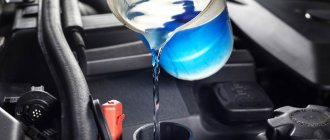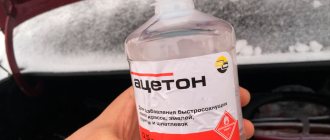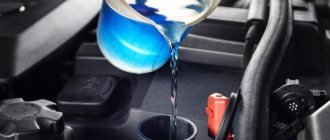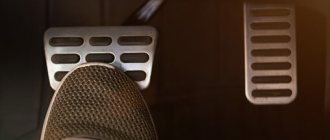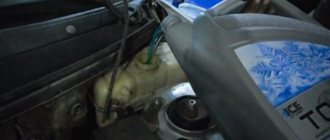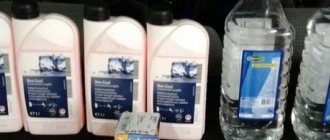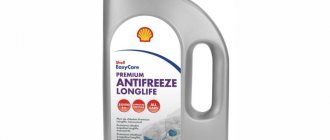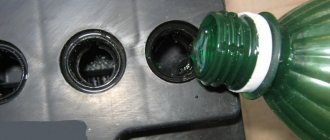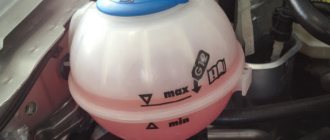The lion's share of car owners have repeatedly found themselves in an extremely unpleasant situation when there was nothing else in the car except a screwdriver and a couple of wrenches. The same applies to cases of sudden leakage of antifreeze: you cannot drive further without it, but technical assistance is very far away. Therefore, there is an ambiguous question: is it possible to dilute antifreeze with water? Of course, there are experienced drivers who are clearly against this approach - they say it will damage the car, and sometimes it can even lead to major repairs. Other experts hold the opposite opinion, and to understand this matter, you need to start from the very basics.
What is antifreeze and what is its feature?
Antifreeze is a coolant designed to prevent the engine from overheating in the summer and from cooling to an unacceptable temperature in the winter. These properties are explained by the composition of the chemical, consisting of distilled water and ethylene glycol. However, some manufacturers also add some additives to it, the amount of which is no more than 2%. If you break this rule, the liquid also acquires negative qualities - it can corrode not only rubber, but even metal.
So, is it possible to mix antifreeze with water? Yes, because it is often a concentrated chemical that clearly requires dilution. However, a competent approach is important. Accordingly, you should first read the manufacturer’s instructions, which indicate the required volume of diluent. After all, each refrigerant has a specific density indicator at which it performs its role both at strong plus and minus temperatures. In addition, if we are talking about a concentrate, then it cannot be mixed with ordinary water. Accordingly, before the procedure you need to have a distillate on hand.
Summarizing
The cooling system of modern cars is very sensitive to the quality of the liquid being poured, therefore experts categorically do not recommend experimenting with solutions; they advise choosing products that meet the standards declared by the vehicle manufacturers. From careless handling of the liquid being poured, not only the elements of the cooling system can suffer, but also the engine, as the main working unit of the vehicle.
Do not neglect the rules described above; if necessary, dilute antifreeze to the required concentration in the summer, use only distillate, and in winter, absolutely refuse the option of diluting the substance. Having a spare container with antifreeze and distillate in the trunk of your car will help protect you from unforeseen situations: a leak, even far from civilization, will be solved by properly replenishing the liquid, without the risk of harming the system.
Under what circumstances is it acceptable to dilute?
Despite numerous prohibitions and restrictions, car owners sometimes have to violate them. After all, if the refrigerant has partially leaked out, then what happens if antifreeze is mixed with water is not very important. It is better to take the risk than to continue driving with insufficient quantities of this chemical. However, there is a “golden” rule that should be strictly adhered to: the volume of added distilled water cannot exceed the volume of the remaining coolant. Alas, sometimes the driver simply has no choice - when the refrigerant has leaked or evaporated completely, and in order to get to the nearest auto shop or repair shop, he has to “drive” on water alone. However, you should move at minimum speed, otherwise the engine will quickly overheat.
How to add antifreeze correctly
We will consider the procedure using the example of the mentioned Hyundai Solaris car. However, most of the above actions and reasoning will be valid for most other machines. The differences relate only to the location of individual components and mechanisms (in particular, the expansion tank).
Remember that you only need to add antifreeze when it’s cold, that is, when the engine and cooling system are cool. Otherwise, you risk getting burned!
So, in the Hyundai Solaris, the expansion tank of the cooling system is located on the right side of the engine compartment, directly on the system fan casing. The procedure itself is performed according to the following algorithm:
Location of the coolant expansion tank for Hyundai Solaris
- It is advisable to install the machine on a slope so that its front part is higher. This is done so that the air leaves the system without obstruction. However, if you plan to add a small amount of liquid, then this recommendation can be ignored.
- You need to take a rag, cover the expansion tank cap with it, and carefully unscrew it. This is necessary in order to protect clothing and skin from possible splashes if there is excess pressure in the system.
- Add coolant directly. Remember that it is necessary to top up in a thin stream so that at the same time the air contained there comes out of the system and an air lock does not form. That is, in such a way that when adding, air bubbles do not form on the surface of the liquid. Otherwise, you will need to “drive out” the traffic jam, which is associated with additional problems.
- Add liquid to a level approximately ⅔ of the tank volume , closer to the maximum mark. After this, start the engine and let it run for 3...5 minutes. During this time, the antifreeze will spread throughout the system and its level in the tank may drop.
- If this happens, the topping up procedure must be repeated, and then start the engine again. This must be done until after the next engine start the fluid level remains at the same level (in most cases, if you need to add a small amount of fluid, one such cycle will be enough).
- After completing the procedure, use a rag to get rid of possible antifreeze splashes on the surface of the tank or other elements in the engine compartment, and tighten the tank cap.
We recommend that you do not throw away the antifreeze canister . If there is still liquid left, you can add it again in the future. And if the canister remains empty, you will always have at hand information about what brand of coolant was used. Accordingly, in the future you will be able to buy a new, similar composition.
Useful tips
Since the car's cooling system is an important component, it is very useful to keep an eye on it. The same goes for the engine oil level or the general condition of the power unit. Accordingly, you can mix antifreeze with water to prevent even greater problems with the engine. And yet, so that this does not lead to extremely negative consequences, you need to adhere to a number of useful recommendations.
Pouring tap water into the coolant is more expensive, because this creates a high probability of the formation of harmful sediment that can damage the cooling system. This should only be done as a last resort, and when you get to a technical center or garage, flushing the entire system is definitely recommended.
The best option is to dilute the antifreeze with distilled water. Moreover, there is no need to make any complex calculations: in summer the proportion is 1:1, and in the cold season 7:3. Why is this so? The point is that the more concentrated the chemical, the less it will freeze in the cold.
Since the refrigerant evaporates quickly in the summer, it has to be diluted. In winter, this should not be done: if the temperature drops to 15-20 degrees, then starting the engine will be very problematic.
Many experts still debate whether it is possible to dilute antifreeze with water under extreme circumstances. And some of them are inclined to express a seemingly paradoxical opinion: it is better to completely remove the chemical from the system by pouring distilled water into it. They say that for some time it can replace technical fluid.
If regular antifreeze is filled
Ready-made antifreeze can also be diluted with distilled water if its level has decreased slightly, by two hundred to three hundred milliliters. It is strictly forbidden to use tap water, because it contains impurities that can enter into an unpredictable reaction with antifreeze additives - especially if a concentrate was used. Modern cars contain aluminum in the cooling system, which corrodes when in contact with hard water.
If it is not possible to buy distilled water (which is inexpensive), you can use soft water, thoroughly purified through filters, pre-boiled, after which it is recommended to change the antifreeze cavity at the first opportunity.
How long can you move on “water alone”?
As already mentioned, diluting antifreeze with water is only a last resort when there is simply no other way to get to the service station. Accordingly, water should be removed as soon as possible, because it cannot completely replace the factory refrigerant.
How long it is permissible to ride “on water” depends on many factors. Including the technical condition of the car, mileage and even the year of manufacture of the vehicle. However, as practice shows, you can move for a couple of hours without negative consequences. And if the engine is practically new or has been overhauled, then much more. And yet, you can’t thoughtlessly risk your car, otherwise subsequent repairs can cost quite a lot of money.
What can be replaced?
No other liquid is suitable for diluting antifreeze . Neither tap nor boiled water is suitable for this. Even in water purified by a regular filter, salts and impurities still remain.
When they are added, the mixture loses its anti-corrosion properties. Due to poor quality water, all car systems will quickly fail.
Attention! Melt water and rainfall should not be used instead of distillate. They still contain foreign impurities.
How often to change?
Just like oil, antifreeze has its own replacement period. Manufacturers say that the fluid must be changed every 3 years or 75 thousand kilometers. During operation, the level of heat transfer of antifreeze decreases. It begins to foam and corrode metal parts. If you do not know when antifreeze was added to the system, its wear is very easy to determine. A jelly-like mass forms on the inside of the expansion tank; at subzero temperatures, the liquid becomes cloudy and precipitates. Wear can also be determined by color. If the antifreeze turns red, this indicates that the corrosion process has begun.
Yes, manufacturers paint antifreeze in different shades - red, blue, green. But you won’t confuse dirty liquid with anything. If the above symptoms appear, replace the antifreeze immediately. And water is never added to the new liquid. If one canister is missing, buy another one. Even if you still have 4 liters left in it, you will have a full-fledged concentrate. In addition, the water that is in it tends to evaporate. Therefore, the remaining liters will be “topping up”.
Where does the antifreeze go?
As you can see, the antifreeze already contains water, albeit distilled, from here you can immediately understand that adding water to the system at a low level is theoretically quite possible.
But at the same time, it is important to know how to do everything correctly so that there are no negative impacts from this.
A decrease in antifreeze level usually occurs in two cases:
- Evaporation (even though the water is distilled, it still changes its state of aggregation when exposed to high temperatures);
- Violation of the tightness of the system (loose clamp of the pipes, cracks in them and in the radiator).
In the first case, the loss of antifreeze is relatively insignificant, but in the second case, almost all of the liquid can leak out of the system if the leak is not noticed and corrected in time.
This is the first factor to consider when replenishing your level.
The second is weather conditions. It was noted above that a violation of proportions leads to a decrease in the temperature threshold for freezing of liquid.
When a lot of antifreeze has gone
First you need to determine the cause, namely, inspect the engine compartment for leaks. Is there a puddle under the hood? Pay attention to all connections and hoses for cracks. Feel them with your hands - they should not be wet. Pull all the clamps through. This is how the expansion tank can leak, especially when it heats up during prolonged operation of the engine and the “coolant” begins to leak through microcracks.
If the coolant leaks frequently and in large quantities, then first eliminate the cause, otherwise there is no point in adding new fluid.
When the problem is fixed and you know what was filled in earlier, then use the original (by color, from the same manufacturer) antifreeze to top up. If it is unknown what was filled in, then in the warm season you can add distilled water, and before the onset of cold weather, completely replace the antifreeze.
In case of a large leak , when more than a third of the volume needs to be added, it is better to replace the entire antifreeze. In extreme cases (far from shops and civilization, when you need to get to a repair site), you can fill in any quantity of water in the summer (preferably filtered), it does not affect the cooling capacity of the engine.
In winter, you can fill it with water, but as soon as you get to the repair site, drain it immediately. Otherwise, it will freeze and may damage parts of the cooling system during the first frosty start.
About flowers
Green and red antifreeze are very popular now. Their prices are approximately the same. But there are differences. Green has several components:
- Organic substances.
- Inorganic.
- Chemical additives. They are borates, phosphates and carboxylic acid.
The advantage of using green antifreeze is the composition’s high resistance to corrosion. The mixture seems to “envelop” the insides with a protective film, preventing processes that are destructive to the metal. But there is also a minus here.
This film reduces the heat dissipation of the liquid. But this does not have a detrimental effect on the engine. If used correctly, it is very difficult for an engine to boil on green antifreeze. As for red antifreeze, their composition excludes the use of inorganic components. There is also a high percentage of carboxylic acid content. It does not form films inside the system, hence better heat transfer.
They also have an increased service life. High-quality red antifreeze lasts up to 5 years. However, the mixture has its drawbacks. This is primarily poor protection of aluminum radiators from scale. But if you have a copper or brass radiator, red antifreeze is the perfect choice for you. It is also sold in 5-liter cans. One of the popular ones. Reviews from motorists note a low freezing threshold - up to minus 35 degrees Celsius. The liquid does not boil at 110, but still you should not bring the engine to this state. This is very harmful for him.
Winter time
During this period, adding water is strictly prohibited, even in small quantities. As a result, starting the engine at -5 degrees or more will be difficult. Frozen water due to expansion can rupture the radiator, pipes and tank. According to the requirements, the freezing point of antifreeze must be at least -25 degrees. With every milliliter of water added, this figure decreases.
What makes motorists dilute antifreeze?
As you know, antifreeze (coolant) regulates the temperature conditions of a running engine. In summer, the composition does not allow the power unit to overheat, and in winter it does not freeze. The technical composition of the developments is represented by a combination of two main substances:
- water distillate (35%);
- ethylene glycol (63%).
To prevent corrosion processes and extraneous chemical reactions when air masses enter, the manufacturer enriches antifreeze with various additives (2%).
Manufacturers do not recommend
Depending on the manufacturer, these ratios may be different, but the mixture is always characterized by clear proportions. Therefore, before pouring anything into antifreeze, you need to read the instructions. Each brand of coolant has a set viscosity value at which the composition is effective. Viscosity affects the freezing or evaporation point in hot weather.
Not a single manufacturer recommends adding water to antifreeze. Unless, of course, it is a factory concentrate originally intended for dilution. When the car owner uses a fully prepared composition, experiments are extremely undesirable. Technical fluid is a collection of chemical compounds, and if you thoughtlessly dilute it with water, you can destroy the entire cooling system.
If you really need it, you can
It is difficult to scare a domestic motorist. Moreover, in practice, situations often occur when there is simply nowhere to get antifreeze (there are no car shops nearby, etc.) or a person simply experiences financial difficulties.
For such cases, there is an unwritten rule in the automotive environment: It is impossible to dilute the coolant, but if antifreeze cannot be purchased, and its level is outrageously low, then it is very possible.
Then water is added instead of antifreeze. Without getting too carried away, of course, without building it into a system and taking into account the accumulated trial and error. The main thing is to dilute it so as to maintain the balance of the liquid (there should not be more water).
